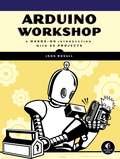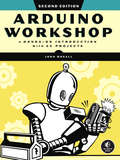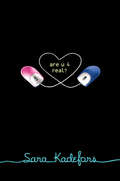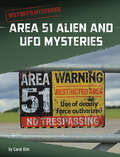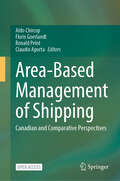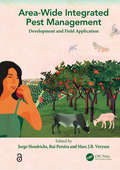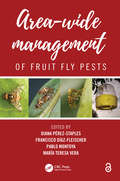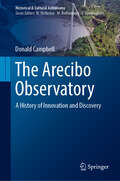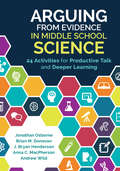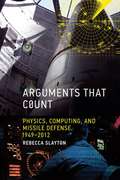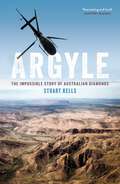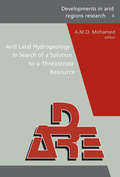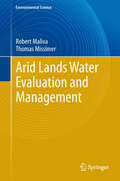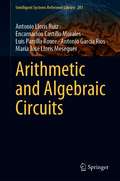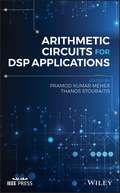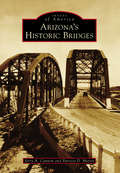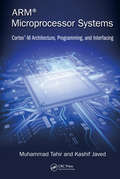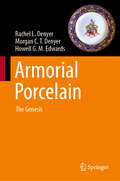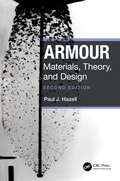- Table View
- List View
Arduino VII: Industrial Control (Synthesis Lectures on Digital Circuits & Systems)
by Steven F. BarrettThis book is about the Arduino microcontroller and the Arduino concept. The visionary Arduino represented a new innovation in microcontroller hardware in 2005, the concept of open source hardware, making a broad range of computing accessible for all. This book, “Arduino VII: Industrial Control,” is an accessible primer on industrial control and programmable logic controller concepts for those without a deep instrumentation background. An understanding of basic circuit theory is an appropriate prerequisite for the book. The three main goals for the book are: explore accessible Arduino Opta industrial control products; learn the fundamentals of programming using ladder logic; and explore related sensors and interface concepts. We use multiple examples throughout the book and conclude with an instrumented greenhouse project.
Arduino Workshop: A Hands-On Introduction with 65 Projects
by John BoxallThe Arduino is a cheap, flexible, open source microcontroller platform designed to make it easy for hobbyists to use electronics in homemade projects. With an almost unlimited range of input and output add-ons, sensors, indicators, displays, motors, and more, the Arduino offers you countless ways to create devices that interact with the world around you.In Arduino Workshop, you'll learn how these add-ons work and how to integrate them into your own projects. You'll start off with an overview of the Arduino system but quickly move on to coverage of various electronic components and concepts. Hands-on projects throughout the book reinforce what you've learned and show you how to apply that knowledge. As your understanding grows, the projects increase in complexity and sophistication.Among the book's 65 projects are useful devices like:– A digital thermometer that charts temperature changes on an LCD–A GPS logger that records data from your travels, which can be displayed on Google Maps– A handy tester that lets you check the voltage of any single-cell battery– A keypad-controlled lock that requires a secret code to openYou'll also learn to build Arduino toys and games like:– An electronic version of the classic six-sided die– A binary quiz game that challenges your number conversion skills– A motorized remote control tank with collision detection to keep it from crashingArduino Workshop will teach you the tricks and design principles of a master craftsman. Whatever your skill level, you'll have fun as you learn to harness the power of the Arduino for your own DIY projects.Uses the Arduino Uno board
Arduino Workshop, 2nd Edition: A Hands-on Introduction with 65 Projects
by John BoxallLong-awaited revision of this best-selling book on the Arduino electronics platform (35,000+ copies sold). Readers gain an in-depth understanding of the Arduino -- beyond just making simple projects.The Arduino is an inexpensive, flexible microcontroller platform that makes it easy for hobbyists to use electronics in DIY projects. With its wide range of input and output add-ons, sensors, indicators, displays, and motors, the Arduino offers you countless ways to create interactive devices. Through 65 hands-on projects, Arduino Workshop will teach you the tricks and design principles of a master craftsman. This edition has been updated for the latest version of the Arduino IDE and revised to reflect current hardware and technology. It includes coverage of general electronics concepts as well as schematic diagrams and detailed images of components. You&’ll experiment with touchscreens and LED displays, explore robotics, use sensors with wireless data links, and control devices remotely with a cell phone. Build projects like: • An electronic version of the classic six-sided die • A GPS logger that records and displays travel data • A keypad-controlled lock that opens with a secret code • A binary quiz game • A motorized remote control car with collision detection Whatever your skill level, you&’re sure to have fun as you learn to harness the power of the Arduino for your own DIY projects. NEW TO THIS EDITION: • A chapter on creating your own Arduino libraries • Updated robotic vehicle projects • Newer shields that leverage GPS, 3G, and LoRa data transmission capabilities • A chapter on MAX7219-based numeric LED displays and LED matrix modules Covers Arduino IDE 2.x
Are U 4 Real?
by Sara KadeforsKyla is exactly the kind of girl Alex could never talk to in real life. She's a gorgeous, outspoken L. A. girl who parties to forget about her absent father and depressed mother. He's a shy ballet dancer from outside San Francisco who's never been kissed. Luckily, when these sixteen-year-olds meet for the first time it's not in real life-it's in a chat room, where they can share their feelings of isolation and frustration away from the conformity-obsessed high school scene. Alex and Kyla quickly forge a friendship that's far from virtual- maybe they're even falling in love. But what happens when the soul mate you've never met moves from online to in person? Sara Kadefors's wildly romantic, award-winning Swedish bestseller perfectly captures the universal angst of being a teenager, and the perhaps even more universal struggle to negotiate identity in a multi-platform world.
Area 51 Alien and UFO Mysteries (History's Mysteries)
by Carol KimA highly secure military base sits in the middle of the Nevada Desert. What happens inside is kept top secret. Many UFO sightings have been reported nearby. Some people even say alien bodies are stored there. What really goes on behind its highly guarded fences? Explore the theories and learn why Area 51 has become one of history’s greatest mysteries.
Area-Based Management of Shipping: Canadian and Comparative Perspectives
by Claudio Aporta Aldo Chircop Floris Goerlandt Ronald PelotThis open access book fills a gap in the literature on shipping in a number of cross-cutting fields (including marine transportation law and policy, law of the sea, Indigenous rights, marine environmental management, and risk and safety studies). Moreover, the book includes a focus on the consideration of Indigenous rights in shipping, a topic of emerging importance. There are, to our knowledge, no directly competing titles with the same interdisciplinary approach to conceptualize, understand, and describe best practices for area-based management approaches. There are, however, related titles which cover some aspects of area-based management, usually from narrow disciplinary perspectives. Area-based management in the governance of shipping has become a useful and effective approach to promote maritime safety, maritime security, and pollution prevention and to mitigate the adverse impacts of shipping on the marine environment and coastal communities. Based on the results of a research project and a major workshop convened at Dalhousie University in Canada, this book consists of multidisciplinary studies and analyses of major issues pertaining to area-based management in shipping from a comparative perspective, but with the principal focus on Canada. The book contains both theoretical and empirical contributions.
Area-wide Integrated Pest Management: Development and Field Application
by Jorge Hendrichs; Rui Pereira; Marc J.B. VreysenOver 98% of sprayed insecticides and 95% of herbicides reach a destination other than their target species, including non-target species, air, water and soil. The extensive reliance on insecticide use reduces biodiversity, contributes to pollinator decline, destroys habitat, and threatens endangered species. This book offers a more effective application of the Integrated Pest Management (IPM) approach, on an area-wide (AW) or population-wide (AW-IPM) basis, which aims at the management of the total population of a pest, involving a coordinated effort over often larger areas. For major livestock pests, vectors of human diseases and pests of high-value crops with low pest tolerance, there are compelling economic reasons for participating in AW-IPM. This new textbook attempts to address various fundamental components of AW-IPM, e.g. the importance of relevant problem-solving research, the need for planning and essential baseline data collection, the significance of integrating adequate tools for appropriate control strategies, and the value of pilot trials, etc. With chapters authored by 184 experts from more than 31 countries, the book includes many technical advances in the areas of genetics, molecular biology, microbiology, resistance management, and social sciences that facilitate the planning and implementing of area-wide strategies. The book is essential reading for the academic and applied research community as well as national and regional government plant and human/animal health authorities with responsibility for protecting plant and human/animal health.
Area-Wide Management of Fruit Fly Pests
by Pablo Montoya Diana Perez-Staples Francisco Diaz-Fleischer Maria Teresa VeraFruit fly (Diptera: Tephritidae) pests have a profound impact on horticultural production and economy of many countries. It is fundamental to understand their biology and evaluate methods for their suppression, containment, or eradication. Area-Wide Management of Fruit Fly Pests comprises contributions from scientists from around the world on several species of tephritids working on diverse subjects with a focus on area-wide management of these pests. The first three sections of the book explore aspects of the biology, ecology, physiology, behavior, taxonomy, and morphology of fruit flies. The next two sections provide evidence on the efficacy of attractants, risk assessment, quarantine, and post-harvest control methods. The fifth and sixth sections examine biological control methods such as the Sterile Insect Technique and the use of natural enemies of fruit flies. The seventh section focuses on area-wide integrated pest management and action programs. Finally, the eighth section examines social, economic, and policy issues of action programs aimed at involving the wider community in the control of these pests and facilitate the development of control programs. Features: Presents information on the biology of tephritid flies. Provides knowledge on the use of natural enemies of fruit flies for their biological control. Includes research results on models and diets used for the Sterile Insect Technique. Reports developments on the chemical ecology of fruit flies that contribute to make control methods more specific and efficient. Reviews subjects such as Holistic Pest Management and Area-Wide Management Programs including social, economic, and policy issues in various countries.
The Arecibo Observatory: A History of Innovation and Discovery (Historical & Cultural Astronomy)
by Donald CampbellWritten by its former Director, this book presents a historical account of the famous Arecibo Observatory and its 305-meter radio astronomical telescope, widely known for its groundbreaking scientific discoveries and starring role in the James Bond movie, Golden Eye.The story details the planning, funding and construction of the telescope; the people who masterminded and contributed to the project; and the involvement of the US Department of Defense in funding the construction. It also includes the seminal scientific achievements in the three research areas to which the telescope contributed, ionospheric physics, planetary science and radio astronomy.The book continues through later upgrades made to the site, showing how the Arecibo telescope has arguably remained the world’s most versatile and productive radio science instrument for over 50 years. This historical account will fascinate astronomers and historians of science, serving as a valuable contribution to the history of 20th century astronomy.
Arena of Monsters (Escape from Planet Alcatraz)
by Michael DahlZak Nine has been captured and placed in Planet Alcatraz's "Monster Zoo." But this isn't any ordinary zoo. This zoo holds dozens of alien "monsters" who are forced to fight for the entertainment of the prison planet's owners. Zak's friend, Erro, is determined to break into the zoo to rescue the human boy. Erro will need to rely on his Quom survival skills to succeed. Will he be able to find Zak, avoid the zoo's Overseers, and find a way out?
Arguing From Evidence in Middle School Science: 24 Activities for Productive Talk and Deeper Learning
by Brian M. Donovan Anna C. MacPherson Andrew J. Wild Jonathan Francis Osborne J. (Joseph) HendersonTeaching your students to think like scientists starts here! If you’ve ever struggled to help students make scientific arguments from evidence, this practical, easy-to-use activity book is for you! Give your students the critical scientific practice today′s science standards require. You’ll discover strategies and activities to effectively engage students in arguments about competing data sets, opposing scientific ideas, applying evidence to support specific claims, and more. 24 ready-to-implement activities drawn from the physical sciences, life sciences, and earth and space sciences help teachers to: Align lessons to the Next Generation Science Standards (NGSS) Engage students in the 8 NGSS science and engineering practices Establish rich, productive classroom discourse Facilitate reading and writing strategies that align to the Common Core State Standards Extend and employ argumentation and modeling strategies Clarify the difference between argumentation and explanation Includes assessment guidance and extension activities. Learn to teach the rational side of science the fun way with this simple and straightforward guide!
Arguing From Evidence in Middle School Science: 24 Activities for Productive Talk and Deeper Learning
by Brian M. Donovan Anna C. MacPherson Andrew J. Wild Jonathan Francis Osborne J. (Joseph) HendersonTeaching your students to think like scientists starts here! If you’ve ever struggled to help students make scientific arguments from evidence, this practical, easy-to-use activity book is for you! Give your students the critical scientific practice today′s science standards require. You’ll discover strategies and activities to effectively engage students in arguments about competing data sets, opposing scientific ideas, applying evidence to support specific claims, and more. 24 ready-to-implement activities drawn from the physical sciences, life sciences, and earth and space sciences help teachers to: Align lessons to the Next Generation Science Standards (NGSS) Engage students in the 8 NGSS science and engineering practices Establish rich, productive classroom discourse Facilitate reading and writing strategies that align to the Common Core State Standards Extend and employ argumentation and modeling strategies Clarify the difference between argumentation and explanation Includes assessment guidance and extension activities. Learn to teach the rational side of science the fun way with this simple and straightforward guide!
Arguments that Count: Physics, Computing, and Missile Defense, 1949-2012 (Inside Technology)
by Rebecca SlaytonHow differing assessments of risk by physicists and computer scientists have influenced public debate over nuclear defense.In a rapidly changing world, we rely upon experts to assess the promise and risks of new technology. But how do these experts make sense of a highly uncertain future? In Arguments that Count, Rebecca Slayton offers an important new perspective. Drawing on new historical documents and interviews as well as perspectives in science and technology studies, she provides an original account of how scientists came to terms with the unprecedented threat of nuclear-armed intercontinental ballistic missiles (ICBMs). She compares how two different professional communities—physicists and computer scientists—constructed arguments about the risks of missile defense, and how these arguments changed over time. Slayton shows that our understanding of technological risks is shaped by disciplinary repertoires—the codified knowledge and mathematical rules that experts use to frame new challenges. And, significantly, a new repertoire can bring long-neglected risks into clear view.In the 1950s, scientists recognized that high-speed computers would be needed to cope with the unprecedented speed of ICBMs. But the nation's elite science advisors had no way to analyze the risks of computers so used physics to assess what they could: radar and missile performance. Only decades later, after establishing computing as a science, were advisors able to analyze authoritatively the risks associated with complex software—most notably, the risk of a catastrophic failure. As we continue to confront new threats, including that of cyber attack, Slayton offers valuable insight into how different kinds of expertise can limit or expand our capacity to address novel technological risks.
Arguments that Count
by Rebecca SlaytonIn a rapidly changing world, we rely upon experts to assess the promise and risks of new technology. But how do these experts make sense of a highly uncertain future? In Arguments that Count, Rebecca Slayton offers an important new perspective. Drawing on new historical documents and interviews as well as perspectives in science and technology studies, she provides an original account of how scientists came to terms with the unprecedented threat of nuclear-armed intercontinental ballistic missiles (ICBMs). She compares how two different professional communities -- physicists and computer scientists -- constructed arguments about the risks of missile defense, and how these arguments changed over time. Slayton shows that our understanding of technological risks is shaped by disciplinary repertoires -- the codified knowledge and mathematical rules that experts use to frame new challenges. And, significantly, a new repertoire can bring long-neglected risks into clear view. <P> In the 1950s, scientists recognized that high-speed computers would be needed to cope with the unprecedented speed of ICBMs. But the nation's elite science advisors had no way to analyze the risks of computers so used physics to assess what they could: radar and missile performance. Only decades later, after establishing computing as a science, were advisors able to analyze authoritatively the risks associated with complex software -- most notably, the risk of a catastrophic failure. As we continue to confront new threats, including that of cyber attack, Slayton offers valuable insight into how different kinds of expertise can limit or expand our capacity to address novel technological risks.
Argyle: The Impossible Story of Australian Diamonds
by Stuart KellsThe remote Kimberley region of Western Australia has a rich history and unique geography. In the 1960s De Beers, the world's largest diamond company, sent gem-hunters to the area but they came away empty-handed. It was a vast region to survey, and they'd overlooked something vital. A few years later, a team of Australian geologists with a tiny budget searched for even tinier mineral clues. Those clues led them to the earth's largest diamond deposit and the world's richest source of rare pink diamonds. Based on in-depth research and interviews - including with Alan King Jones, Bill Leslie and 'the father of Australian diamonds', Ewen Tyler - Argyle: The Impossible Story of Australian Diamonds details the almost overwhelming challenges with realising a diamond mining venture in Australia, shows how these obstacles were overcome, and explores the mine's impact and legacy.
Arid Land Hydrogeology: Proceedings of the Third Joint UAE-Japan Symposium on Sustainable GCC Environment and Water Resources (EWR2006), 28 - 30 January 2006, Abu Dhabi, UAE (Volume IV in DARE series) (Developments in Arid Regions Research Series)
by A.M.O. MohamedThere are many urgent problems in arid land hydrogeology and it is these issues which are tackled in this volume on desert environments. The UAE-Japan symposia provide a venue for the exchange of expertise, confronting such problems as purification, usage and management of groundwater, the assessment and protection of sustainable water resources, a
Arid Lands Water Evaluation and Management (Environmental Science and Engineering)
by Robert Maliva Thomas MissimerA large part of the global population lives in arid lands which have low rainfall and often lack the water required for sustainable population and economic growth. This book presents a comprehensive description of the hydrogeology and hydrologic processes at work in arid lands. It describes the techniques that can be used to assess and manage the water resources of these areas with an emphasis on groundwater resources, including recent advances in hydrologic evaluation and the differences between how aquifer systems behave in arid lands versus more humid areas. Water management techniques are described and summarized to show how a more comprehensive approach to water management is required in these areas, including the need to be aware of cultural sensitivities and conditions unique to many arid regions. The integration of existing resources with the addition of new water sources, such as desalination of brackish water and seawater, along with reusing treated wastewater, will be required to meet future water supply needs. Also, changing climatic conditions will force water management systems to be more robust so that future water supply demands can be met as droughts become more intense and rainfall events become more intense. A range of water management techniques are described and discussed in order to illustrate the methods for integrating these measures within the context of arid lands conditions.
Arithmetic and Algebraic Circuits (Intelligent Systems Reference Library #201)
by Antonio Lloris Ruiz Encarnación Castillo Morales Luis Parrilla Roure Antonio García Ríos María José Lloris MeseguerThis book presents a complete and accurate study of arithmetic and algebraic circuits. The first part offers a review of all important basic concepts: it describes simple circuits for the implementation of some basic arithmetic operations; it introduces theoretical basis for residue number systems; and describes some fundamental circuits for implementing the main modular operations that will be used in the text. Moreover, the book discusses floating-point representation of real numbers and the IEEE 754 standard. The second and core part of the book offers a deep study of arithmetic circuits and specific algorithms for their implementation. It covers the CORDIC algorithm, and optimized arithmetic circuits recently developed by the authors for adders and subtractors, as well as multipliers, dividers and special functions. It describes the implementation of basic algebraic circuits, such as LFSRs and cellular automata. Finally, it offers a complete study of Galois fields, showing some exemplary applications and discussing the advantages in comparison to other methods. This dense, self-contained text provides students, researchers and engineers, with extensive knowledge on and a deep understanding of arithmetic and algebraic circuits and their implementation.
Arithmetic Circuits for DSP Applications
by Thanos Stouraitis Pramod Kumar MeherA comprehensive guide to the fundamental concepts, designs, and implementation schemes, performance considerations, and applications of arithmetic circuits for DSP Arithmetic Circuits for DSP Applications is a complete resource on arithmetic circuits for digital signal processing (DSP). It covers the key concepts, designs and developments of different types of arithmetic circuits, which can be used for improving the efficiency of implementation of a multitude of DSP applications. Each chapter includes various applications of the respective class of arithmetic circuits along with information on the future scope of research. Written for students, engineers, and researchers in electrical and computer engineering, this comprehensive text offers a clear understanding of different types of arithmetic circuits used for digital signal processing applications. The text includes contributions from noted researchers on a wide range of topics, including a review of circuits used in implementing basic operations like additions and multiplications; distributed arithmetic as a technique for the multiplier-less implementation of inner products for DSP applications; discussions on look up table-based techniques and their key applications; CORDIC circuits for calculation of trigonometric, hyperbolic and logarithmic functions; real and complex multiplications, division, and square-root; solution of linear systems; eigenvalue estimation; singular value decomposition; QR factorization and many other functions through the use of simple shift-add operations; and much more. This book serves as a comprehensive resource, which describes the arithmetic circuits as fundamental building blocks for state-of-the-art DSP and reviews in - depth the scope of their applications.
Arizona's Historic Bridges
by Patricia D. Morris Jerry A. CannonArizona was once just a passage for pioneers headed west for gold, religious freedom, and cheap land. Native Americans had lived in and explored the territory for years, but it was Manifest Destiny and the western expansionist philosophy of the burgeoning US government that created the impetus for better and faster routes across the vast territory with its topographical challenges. In the 1880s, the railroads first booted their way across the landscape, following historic trails before the highways were built. The Grand Canyon and Colorado River were obvious challenges, but there were also seasonal waterways that needed crossings. The history of the state unfolds with this book, profiling the bridges that define these historic transportation routes. Many of them have been proudly restored by their communities or the state, while others are gone or are in a sad state of decline.
ARM Microprocessor Systems: Cortex-M Architecture, Programming, and Interfacing
by Kashif Javed Muhammad TahirThis book presents the use of a microprocessor-based digital system in our daily life. Its bottom-up approach ensures that all the basic building blocks are covered before the development of a real-life system. The ultimate goal of the book is to equip students with all the fundamental building blocks as well as their integration, allowing them to implement the applications they have dreamed up with minimum effort.
The Armchair General: Can You Defeat the Nazis? (The Armchair General #1)
by John BuckleyA ground-breaking approach to history where YOU choose the fate of WWII - perfect for readers of Bletchley Park Brainteasers and The GCHQ Puzzle Book.''An original and exciting approach . . . Buckley is one of our very finest historians.' JAMES HOLLAND________________________TAKE THE HOTSEATAssume the role of real Generals, Leaders, Soldiers and Intelligence Officers in the Allied Forces during WWII, including Winston Churchill and President Eisenhower.EXAMINE THE INTELLIGENCEExplore eight key moments of the war with real contemporaneous intelligence: Britain's Darkest Hour, 1940; The War in North Africa; Stalin's War on the Eastern Front; The Pacific Battle of Midway; The Dresden Bomber Offensive; Casablanca; Arnhem and Operation Market Garden; The Bomb and Hiroshima.CONSIDER THE SCENARIO & MAKE YOUR DECISIONFrom battlefields to war cabinets, each tactical and strategic decision you make leads to a different outcome.Will you follow the path of the past - or shape a new history?________________________'Wonderfully original . . . putting readers at the heart of the decision-making process and allowing them, literally, to change the course of history. This is counterfactual history at its best.' SAUL DAVID'A reminder that history is a never ending now, a relentless and endless present that comes without the luxury of hindsight.' AL MURRAY'An original and exciting approach . . . Buckley is one of our very finest historians. The Armchair General adds enormously to our understanding of the conflicts.' JAMES HOLLAND'A unique, enjoyable approach to evaluating military decision-making.' HISTORY OF WAR
Arming the Periphery
by Emrys ChewA major historical study of the global arms trade, revolving around the transfer of small arms from metropolitan Europe to the turbulent frontiers of Indian Ocean societies during the 'long' nineteenth century (c. 1780-1914).
Armorial Porcelain: The Genesis
by Howell G. Edwards Rachel L. Denyer Morgan C.T. DenyerThis book explores the genesis of armorial porcelain manufacture in Britain. While heraldic devices began appearing on Chinese porcelain from the sixteenth century onwards, armorials did not appear on British porcelain until the 1750s. It examines the development of porcelain in China and traces its introduction to Western Europe. The book delves into the market for armorial porcelains, from the early commissioning of Chinese armorial porcelainware to the establishment of manufactories in England capable of producing armorial porcelain. It also discusses the reasons behind the timing of armorial porcelain's manufacture in Britain. Additionally, it assesses armorial porcelain as a contemporary historical source. Building upon previous research by the authors, the book presents armorial porcelain as a distinct and highly personalized product. By integrating detailed genealogical research, cultural insights, and chemical analysis, it offers a comprehensive understanding of armorial porcelain within the context of heritage, culture, and science.
Armour: Materials, Theory, and Design
by Paul J. HazellUpdated throughout for the new edition, Armour: Materials, Theory, and Design covers extant and emergent protection technologies driving advances in armour systems. Covering materials, theory and design, the book has applications in vehicle, ship, personnel and building use.Introducing a wide range of armour technologies, the book is a key guide to the technology used to protect against both blasts and ballistic attacks. Chapters cover bullets, blasts, jets and fragments, as well as penetration mechanics. The new edition builds on the previous one, discussing ceramics and metallic materials as well as woven fabrics and composite laminates. Detailing modern technology advancements, the second edition has also been expanded to include improved explanations on shock mechanisms and includes significantly more figures and diagrams.An essential guide to armour technology, this book outlines key ways to implement protective strategies applicable for many types of conflict.

